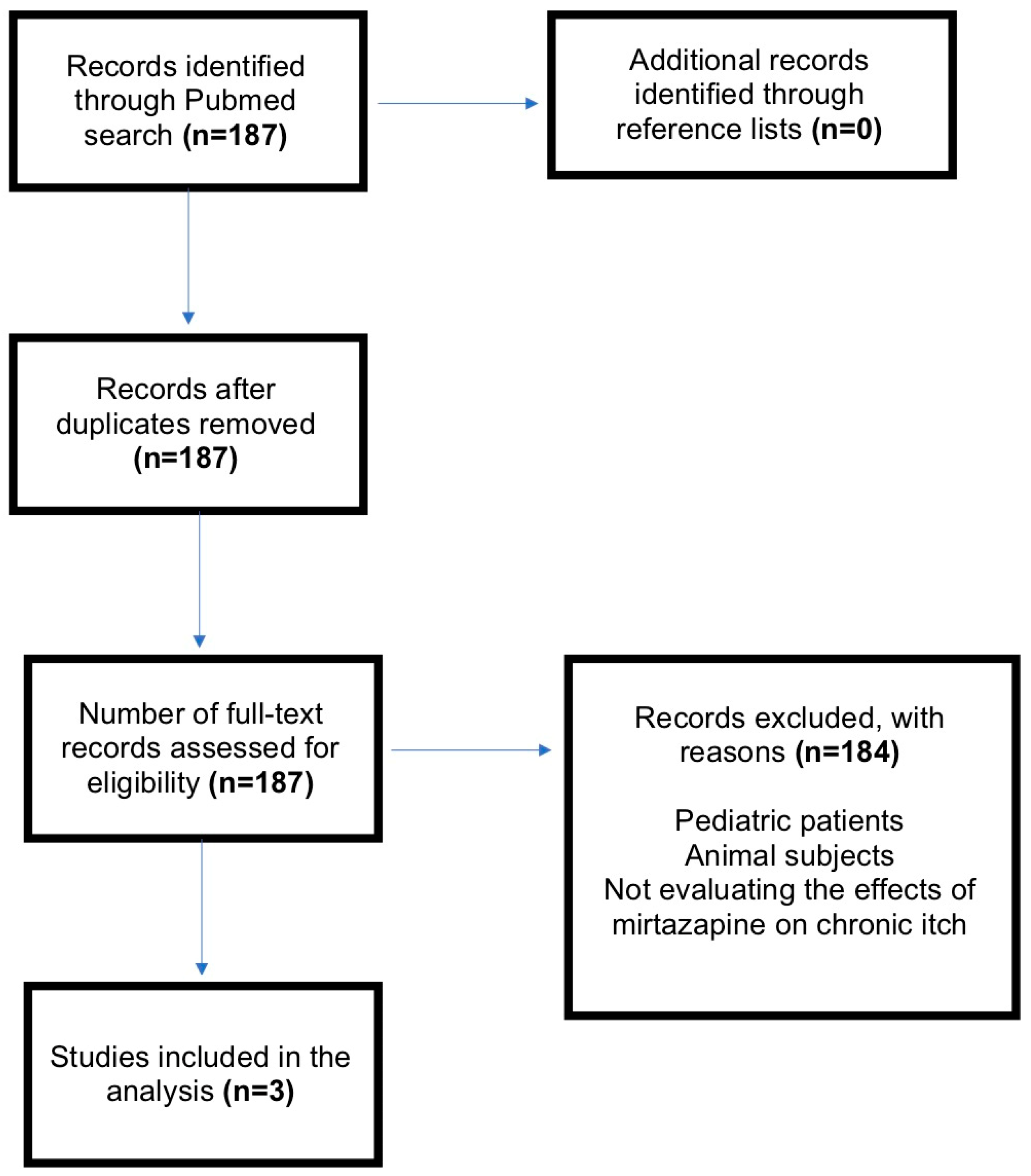Mirtazapine for the Treatment of Chronic Pruritus
Abstract
Author Contributions
Funding
Conflicts of Interest
References
- Dhand, A.; Aminoff, M.J. The neurology of itch. Brain 2014, 137, 313–322. [Google Scholar] [CrossRef] [PubMed]
- Davis, M.P.; Frandsen, J.L.; Walsh, D.; Andresen, S.; Taylor, S. Mirtazapine for Pruritus. J. Pain Symptom Manag. 2003, 25, 288–291. [Google Scholar] [CrossRef]
- Kaur, R.; Sinha, V.R. Antidepressants as antipruritic agents: A review. Eur. Neuropsychopharmacol. 2018, 28, 341–352. [Google Scholar] [CrossRef] [PubMed]
- Boozalis, E.; Khanna, R.; Kwatra, S.G. Selective serotonin reuptake inhibitors for the treatment of chronic pruritus. J. Dermatolog. Treat. 2018, 29, 812–814. [Google Scholar] [CrossRef] [PubMed]
- Boozalis, E.; Khanna, R.; Zampella, J.G.; Kwatra, S.G. Tricyclic antidepressants for the treatment of chronic pruritus. J. Dermatolog. Treat. 2019, 6, 1–3. [Google Scholar] [CrossRef] [PubMed]
- Lee, J.J.; Girouard, S.D.; Carlberg, V.M.; Mostaghimi, A. Effective use of mirtazapine for refractory pruritus associated with carcinoma en cuirasse. BMJ Support. Palliat. Care 2016, 6, 119–121. [Google Scholar] [CrossRef] [PubMed]
- Hundley, J.L.; Yosipovitch, G. Mirtazapine for reducing nocturnal itch in patients with chronic pruritus: A pilot study. J. Am. Acad. Dermatol. 2004, 50, 889–891. [Google Scholar] [CrossRef] [PubMed]
- Davis, M.P.; Dickerson, E.D.; Pappagallo, M.; Benedetti, C.; Grauer, P.A.; Lycan, J. Mirtazepine: Heir apparent to amitriptyline? Am. J. Hosp. Palliat. Med. 2001, 18, 42–46. [Google Scholar] [CrossRef] [PubMed]
- van Laarhoven, A.I.M.; van der Sman-Mauriks, I.M.; Donders, A.R.T.; Pronk, M.C.; van de Kerkhof, P.C.M.; Evers, A.W.M. Placebo Effects on Itch: A Meta-Analysis of Clinical Trials of Patients with Dermatological Conditions. J. Investig. Dermatol. 2015, 135, 1234–1243. [Google Scholar] [CrossRef] [PubMed]
- Kuhn, H.; Mennella, C.; Magid, M.; Stamu-O’Brien, C.; Kroumpouzos, G. Psychocutaneous disease: Pharmacotherapy and psychotherapy. J. Am. Acad. Dermatol. 2017, 76, 795–808. [Google Scholar] [CrossRef] [PubMed]
- Drugs, A. REMERON ® (Mirtazapine) Tablets. Available online: https://www.accessdata.fda.gov/drugsatfda_docs/label/2007/020415s019,021208s010lbl.pdf (accessed on 29 June 2019).

| Grade of Recommendation * | Study Design | Diagnosis | N | Regimen | Degree of Pruritus Reduction | Reference |
|---|---|---|---|---|---|---|
| C | CS | Atopic dermatitis | 2 | 15 mg mirtazapine every day for three months (first patient) and six months (second patient). | Both patients noted a “significant reduction” of nocturnal and daytime pruritus and improvement in sleep. | [7] |
| Lichen simplex chronicus | 1 | 15 mg mirtazapine every day for two months. | Patient noted a complete resolution of nocturnal pruritus and “significant reduction” in daytime pruritus. | |||
| C | CS | Adenocarcinoma of unknown origin | 4 | 15 mg mirtazapine every night until death. | The patient reported complete resolution of pruritus within 24 hours. | [2] |
| Nodular sclerosis Hodgkin’s disease | 15 mg mirtazapine every night. After an unspecified length of time, the dosage was increased to 30 mg every night until death. | The patient reported 75% improvement in pruritic symptoms on 15 mg mirtazapine and complete resolution of itch on 30 mg mirtazapine. | ||||
| Large B-cell lymphoma | 15 mg mirtazapine every night. After an unspecified length of time, the dosage was increased to 30 mg every night and continued for an unspecified length of time. | The patient reported 80% improvement in pruritic symptoms on 15 mg mirtazapine and complete resolution of itch on 30 mg mirtazapine. | ||||
| Advanced renal cell carcinoma | 15 mg mirtazapine every night. One month later, dosage was increased to 30 mg and maintained at that level until death. | The patient reported complete resolution of pruritus on 30 mg mirtazapine. | ||||
| C | CR | Carcinoma en cuirasse | 1 | 15 mg oral mirtazapine every night for an unspecified duration. | The patient reported a decrease in itch intensity from “200/100” pre-treatment to 2/100 twelve hours after starting mirtazapine. | [6] |
© 2019 by the authors. Licensee MDPI, Basel, Switzerland. This article is an open access article distributed under the terms and conditions of the Creative Commons Attribution (CC BY) license (http://creativecommons.org/licenses/by/4.0/).
Share and Cite
Khanna, R.; Boozalis, E.; Belzberg, M.; Zampella, J.G.; Kwatra, S.G. Mirtazapine for the Treatment of Chronic Pruritus. Medicines 2019, 6, 73. https://doi.org/10.3390/medicines6030073
Khanna R, Boozalis E, Belzberg M, Zampella JG, Kwatra SG. Mirtazapine for the Treatment of Chronic Pruritus. Medicines. 2019; 6(3):73. https://doi.org/10.3390/medicines6030073
Chicago/Turabian StyleKhanna, Raveena, Emily Boozalis, Micah Belzberg, John G. Zampella, and Shawn G. Kwatra. 2019. "Mirtazapine for the Treatment of Chronic Pruritus" Medicines 6, no. 3: 73. https://doi.org/10.3390/medicines6030073
APA StyleKhanna, R., Boozalis, E., Belzberg, M., Zampella, J. G., & Kwatra, S. G. (2019). Mirtazapine for the Treatment of Chronic Pruritus. Medicines, 6(3), 73. https://doi.org/10.3390/medicines6030073





